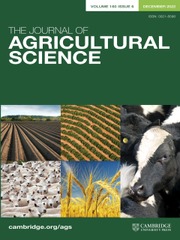Article contents
A study of the process of making stack silage
Published online by Cambridge University Press: 27 March 2009
Extract
An account has been given of an investigation which was designed to test the efficacy of the process of ensilage in the stack for preserving hay crops which are in danger of spoiling in consequence of adverse weather conditions.
The character of the ensiled crops and the weather conditions at the time of ensiling, together with the process of building the stack, have been described in detail.
The results of continuous temperature readings in the stack have been given in graphical form. The significance of the two distinct temperature maxima which characterized the temperature curve has been discussed, and the importance of this method of investigation in regard to the elucidation of the processes which go on during ensilage has been emphasized.
The chemical character of the “sweet” silage samples obtained from experimental bags buried in different parts of the stack has been investigated. The losses of dry matter resulting from fermentation and drainage have been determined and the changes affecting the individual constituents of the crop have been followed quantitatively. The results so obtained have been compared with similar figures referring to the process of ensilage in the tower and the clamp.
It has been shown that the loss of dry matter in the “sweet” silage layers of the stack compares satisfactorily in magnitude with the losses accompanying the preservation of crops in the tower silo and is appreciably smaller than that associated with the production of “sour” silage in the clamp.
Information
- Type
- Research Article
- Information
- Copyright
- Copyright © Cambridge University Press 1926
References
REFERENCES
- 6
- Cited by

